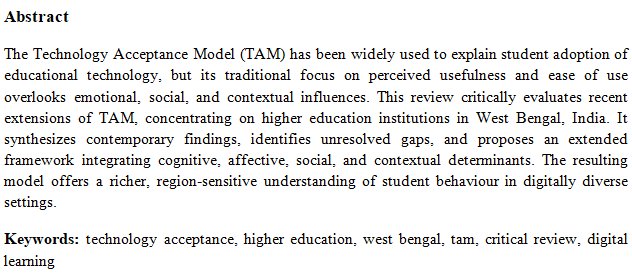Exploring the Determinants of Technology Acceptance Among Students of Higher Education Institutions in West Bengal: A Critical Review
DOI:
https://doi.org/10.5281/zenodo.17568231Keywords:
technology acceptance, higher education, west bengal, tam, critical review, digital learningAbstract
The Technology Acceptance Model (TAM) has been widely used to explain student adoption of educational technology, but its traditional focus on perceived usefulness and ease of use overlooks emotional, social, and contextual influences. This review critically evaluates recent extensions of TAM, concentrating on higher education institutions in West Bengal, India. It synthesizes contemporary findings, identifies unresolved gaps, and proposes an extended framework integrating cognitive, affective, social, and contextual determinants. The resulting model offers a richer, region-sensitive understanding of student behaviour in digitally diverse settings.
Downloads
References
Al-Rahmi, W. M., Othman, M. S., & Yusuf, L. M. (2018). Exploring the factors affecting the use of collaborative learning in higher education: A case study of blended learning. Education and Information Technologies, 23(8), 3135–3154. https://doi.org/10.1007/s10639-018-9757-9
Bagozzi, R. P., & Warshaw, P. R. (2022). Artificial intelligence in education: Opportunities and risks in learning contexts. Computers & Education, 186, 104530. https://doi.org/10.1016/j.compedu.2022.104530
Birch, A., & Burnett, B. (2019). Perceptions of e-learning in higher education: A TAM-based study. Australasian Journal of Educational Technology, 35(5), 46–59. https://doi.org/10.14742/ajet.4648
Cao, Y., Gong, S., Yu, L., & Dai, B. (2017). Exploring determinants of students’ intention to use mobile learning: A structural equation modeling approach. Interactive Learning Environments, 25(8), 1017–1030. https://doi.org/10.1080/10494820.2016.1232277
Chen, J., Xu, B., & Li, X. (2023). Enjoyment and technology adoption: Extending TAM in AI-assisted language learning. Educational Technology Research and Development, 71(2), 567–583. https://doi.org/10.1007/s11423-022-10134-7
Choi, H., & Chung, S. (2017). Applying the technology acceptance model to mobile learning adoption in higher education. International Review of Research in Open and Distributed Learning, 18(4), 120–142. https://doi.org/10.19173/irrodl.v18i4.3077
Davis, F. D. (1989). Perceived usefulness, perceived ease of use, and user acceptance of information technology. MIS Quarterly, 13(3), 319–340. https://doi.org/10.2307/249008
Davis, N., Roblyer, M., & Weller, M. (2021). Evaluating the adoption of e-learning systems through TAM: A meta-analysis. Journal of Educational Computing Research, 59(6), 1157–1184. https://doi.org/10.1177/0735633121998840
Dimitrijević, M., & Devedžić, V. (2021). Technology acceptance in education: A systematic review and meta-analysis. Education and Information Technologies, 26(5), 5659–5686. https://doi.org/10.1007/s10639-021-10573-4
Gong, S., & Yu, L. (2021). Social influence and perceived enjoyment in students’ acceptance of online learning environments. Computers in Human Behavior, 124, 106923. https://doi.org/10.1016/j.chb.2021.106923
Huang, Y., & Zhao, J. (2023). Trust, privacy concerns, and AI adoption in higher education. Computers & Education, 190, 104610. https://doi.org/10.1016/j.compedu.2022.104610
Kang, L. (2023). Motivation and technology acceptance of AI-based learning systems among university students. Interactive Learning Environments, 31(4), 567–583. https://doi.org/10.1080/10494820.2022.2078652
Li, K. (2023). Technology acceptance and student learning motivation in AI-driven higher education. British Journal of Educational Technology, 54(2), 345–362. https://doi.org/10.1111/bjet.13211
Muller, T., Lee, S., & Kallio, J. (2021). Adoption of mobile learning technologies: A cross-cultural study using TAM. Journal of Computer Assisted Learning, 37(1), 45–59. https://doi.org/10.1111/jcal.12537
Patel, R., & Joshi, A. (2023). Extending the technology acceptance model to AI applications in higher education: The role of self-efficacy and compatibility. Education and Information Technologies, 28(6), 7541–7562. https://doi.org/10.1007/s10639-023-11563-1
Saleh, S., Al-Emran, M., & Shaalan, K. (2022). Technology acceptance during COVID-19: A systematic review of TAM applications. Education and Information Technologies, 27(7), 9713–9739. https://doi.org/10.1007/s10639-022-11138-7
Šumak, B., Heričko, M., & Pušnik, M. (2011). A meta-analysis of e-learning technology acceptance: The role of TAM and its extensions. Computers in Human Behavior, 27(6), 2067–2077. https://doi.org/10.1016/j.chb.2011.08.005
Teller, J. (2019). Self-efficacy and digital literacy in the acceptance of learning management systems. Journal of Educational Technology Systems, 48(2), 232–249. https://doi.org/10.1177/0047239519874521
Teller, J., Smith, K., & Brown, M. (2018). Anxiety and barriers to blended learning adoption: An extended TAM approach. Interactive Technology and Smart Education, 15(4), 382–395. https://doi.org/10.1108/ITSE-06-2018-0041
Zhang, L., Wang, X., & Li, Y. (2024). Students’ acceptance of AI-based coding assistants: Extending TAM with trust and compatibility. Computers & Education, 195, 104653. https://doi.org/10.1016/j.compedu.2023.104653

Published
How to Cite
Issue
Section
License
Copyright (c) 2025 Sumana Biswas, Sudipta Majumdar

This work is licensed under a Creative Commons Attribution 4.0 International License.
Research Articles in 'Management Journal for Advanced Research' are Open Access articles published under the Creative Commons CC BY License Creative Commons Attribution 4.0 International License http://creativecommons.org/licenses/by/4.0/. This license allows you to share – copy and redistribute the material in any medium or format. Adapt – remix, transform, and build upon the material for any purpose, even commercially.









